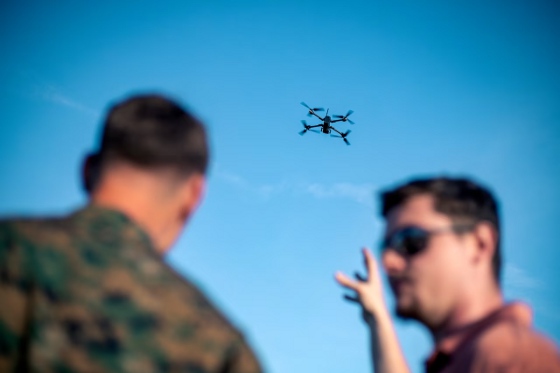 |
| February 28, 2023 | Volume 19 Issue 08 |
Designfax weekly eMagazine
Archives
Partners
Manufacturing Center
Product Spotlight
Modern Applications News
Metalworking Ideas For
Today's Job Shops
Tooling and Production
Strategies for large
metalworking plants
U.S. Department of Defense modernization relies on rapidly leveraging commercial technology
By David Vergun, U.S. Department of Defense
The Defense Innovation Unit of the U.S. Department of Defense (DOD) focuses on leveraging technology from six areas: artificial intelligence/machine learning, autonomy, cyber, energy, human systems, and space.

A Saildrone Explorer unmanned surface vessel is being towed out to sea in the Arabian Gulf off Bahrain's coast, Jan. 27, 2022. U.S. Naval Forces Central Command began operationally testing the unmanned surface vehicle (USV) as part of an initiative to integrate new unmanned systems and artificial intelligence into U.S. 5th Fleet operations. [Credit: Photo by Spc. Natianna Strachen, U.S. Army]
"Our Defense Innovation Unit is focused on identifying priority technology areas using faster methods to get that tech into the hands of our warfighters," said Secretary of Defense Lloyd J. Austin III at the Reagan National Defense Forum in California in December 2022.
The 2022 National Defense Strategy stated that the department must act because market forces are driving new capabilities that could prove useful, particularly in a confrontation with China.
"To gain and maintain operational advantage over competitors, the DOD requires an order-of-magnitude increase in its adoption of commercial technologies. To this end, DOD must act as a fast follower," the NDS states.
In 2022, DIU assisted in transitioning 17 commercial solutions to Defense Department users.
At DIU, transitioning means going from when a prototype successfully completes and results in a production or service contract with a DOD or U.S. Government partner. This process, which typically takes from 12 to 24 months, is extremely fast in the world of government acquisition. Since 2016, a total of 52 projects have transitioned to DOD, said Mike Madsen, acting DIU director.
In FY22, 86% of our awards were non-traditional, 73% were awarded to small businesses, with 33% first-time DOD vendors. "It is critically important that we are working to lower the barriers to entry so that we can grow and strengthen the national security innovation base," said Madsen.
Dual-use commercial technologies play an increasingly important role in how DOD solves problems, he said.
"In particular, the war in Ukraine has increased interest within the national security community on the value of commercially available technology, such as satellite services, communications, and remote sensing," Madsen said.

Marines from the 2nd Reconnaissance Battalion, 2nd Marine Division, operate a Skydio X2 unmanned drone at Camp Lejeune, NC, April 13, 2022. [Credit: Photo by Marine Corps Staff Sgt. Akeel Austin]
Transitioning commercial technologies includes such innovations as delivering enhanced visibility of cyber threats; using AI to optimize talent discovery; and creating scalable, resilient, and responsive communications infrastructure for ground and space systems, he said.
As a joint organization, DIU works with defense partners across the services and combatant commands -- and sometimes civilian or intelligence agencies -- to modernize their efforts by prototyping and scaling this emerging technology. "The growing success of alternative processes to assess, procure, and field commercial technology serves as a harbinger of an innovative 2023 set to further strengthen the foundations of the defense enterprise," he said.
Commercial solutions DIU transitioned to DOD in 2022 include:
- AI-based knowledge graphing.
- Automated vulnerability discovery and remediation.
- Autonomous maritime intelligence, surveillance, and reconnaissance.
- Commercial threat data.
- Cyber threat deception.
- Transforming multi-modal datasets from English and foreign language sources.
- Hall effect thrusters for small satellites designed to increase navigational agility.
- Portable threat-hunting platform designed to eliminate adversary activities in communications.
- Intelligent business automation that monitors financial transactions.
- Peacetime indications and warnings using small satellites.
- Pilot simulation training.
- Rapid analysis of threat exposure for early detection of virus exposure.
- Secure cloud management.
- Short-range reconnaissance using unmanned aerial systems.
Published February 2023
Rate this article
View our terms of use and privacy policy
